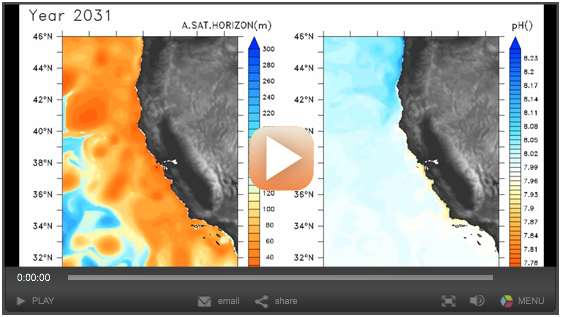Ocean Acidification This Way Comes: A Wake-Up Call for California
Inside a jaw-dropping new study published in the prestigious journal Science

As I stand along the Santa Cruz shore gazing at the vast Pacific Ocean, all looks well. But a silent, unseen threat looms. We knew ocean acidification was a problem in the Pacific Northwest, where highly corrosive seawater threatens oysters and other species whose survival depends on being able to form shells. Acidified waters remove carbonate, a critical building block for many shelled animals like oysters, corals, and a host of other shell-building organisms. But when a new study published in the prestigious journal Science came across my desk last week, it caused my jaw to drop.
If a picture is worth a thousand words, then a video animation of California’s future ocean is worth a million. A team of international scientists, led by Nicolas Gruber from the Swiss Federal Institute of Technology in Zurich, has used high resolution models to show how ocean chemistry will change in the near future. Ocean acidification is the result of our ocean absorbing carbon emissions from the air, and runoff from land. The study indicates that highly acidic water will develop across much of the shore in the next 40 years. This is already affecting people in the states of Oregon and Washington, where oyster operations employ 3,200 people and account for over $100 million in revenue.
Acidified waters are also bathing California and now we know it’s likely to get much worse. Gruber and his colleagues have discovered that ocean acidification will soon become a regular and in some cases permanent feature of waters along the west coast of the United States. California has the largest ocean economy in the country, with vibrant commercial fisheries, aquaculture operations and an economically important tourist industry at risk. Dr. George Waldbusser, an independent expert on OA, commented that coming acidification “will probably have important effects on fisheries, food supply, and general ocean ecology“.
While this future scenario is a daunting one, ocean acidification is finally getting the attention it deserves. The United States just announced its support for a global monitoring network on ocean acidification at the Rio+20 conference; stay tuned here for some related insights from our friends at Sustainable Fisheries Partnership. In the state of Washington, Governor Gregoire has commissioned the nation’s first-ever expert panel to determine what is known about OA in the state and to empower local officials to take action. Its recommendations are due in October.
While ocean acidification is a stark global challenge, we can and must take action to protect businesses, communities and ecosystems. It’s good to see these efforts finally underway because it’s clear from Gruber’s paper that time is running out.